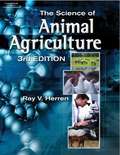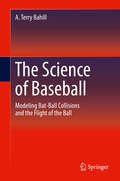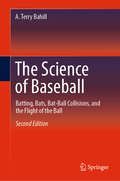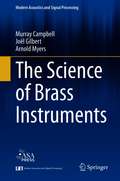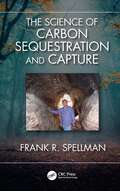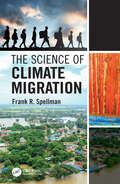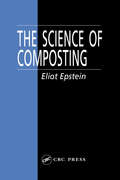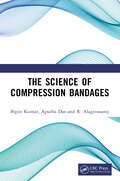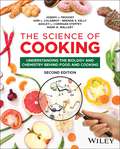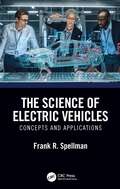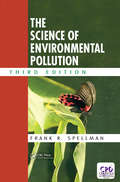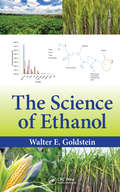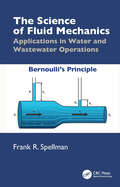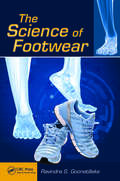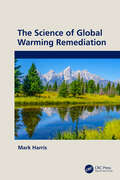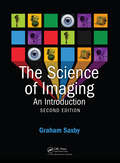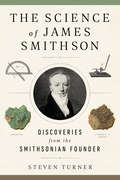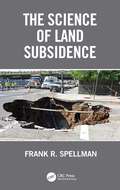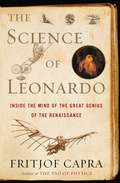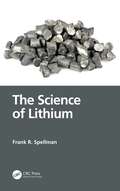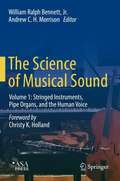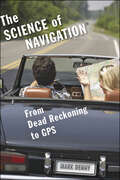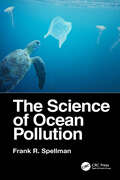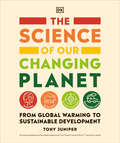- Table View
- List View
The Science of Animal Agriculture (3rd edition)
by Ray V. HerrenThe Science of Animal Agriculture, third edition, is designed for courses aimed at teaching science along with concepts associated with the industry of animal agriculture. This book responds to the current trends in education that promote connecting academic theory with real world applications. Research shows that students gain a better grasp of scientific theory if the theories are taught in an application context, and this text presents the application of biological science used in producing and caring for animals. Topics such as nutrition, anatomy, genetics, entomology, pathology, and animal behavior are covered in depth. These complicated areas are presented in the context of how they are used in the animal industry, allowing the student to make a distinct correlation. Students will benefit from this science-based, animal agriculture text that makes complicated biology principles easy to grasp the context of their application.
The Science of Baseball
by A. Terry BahillThis book describes the dynamic collisions between baseballs, softballs, and bats, and the intricate modeling of these interactions, using only Newton’s basic principles and the conservation laws of physics. Veteran baseball science author Terry Bahill explains models for the speed and spin of balls and bats and equations for bat-ball collisions at a level accessible to high school and undergraduate physics students, engineering students, and, most importantly, students of the science of baseball. Unlike other, more technical accounts of these phenomena that exhibit similar rigor, the models presented in this volume use only basic physical principles to describe simple collision configurations. Elucidating the most important factors for understanding bat performance—bat weight, moment of inertia, the coefficient of restitution, and characteristics of humans swinging the bats, Dr. Bahill also explains physical aspects of the ideal bat and the sweet spot.• Explains how to select or design an optimal baseball or softball bat and create models for bat-ball collisions using only fundamental principles of mechanics from high school physics;• Describes the results of the collision between baseball and bat using basic mathematics such as equations for the speed of the ball after the collision, bat speed after the collision, and bat rotation after the collision;•Accessible to high school and undergraduate students as well as non-technical aficionados of the science of baseball. “Dr. Bahill’s book is the perfect tool for teaching how to solve some of baseball’s basic science problems. Using only simple Newtonian principles and the conservation laws, Dr. Bahill explains how to model bat-ball collisions. Also, he derives equations governing the flight of the ball, and proceeds to show what factors affect air density and how this density affects the ball’s flight. And as a unique addition to his fine book, he provides advice for selecting the optimal bat—a surprising bonus!”Dave Baldwin, PhDMajor League pitcher, 1966-1973, lifetime Major League ERA, 3.08 “If I were the General Manger of a baseball team, I would tell my people to write a ten-page paper describing what this book contains that could improve our performance. I think the book provides the foundation for change.”Bruce GissingExecutive VP-Operations (retired) Boeing Commercial Airplanes“[I] had a chance to read your research, and I fully agree with your findings.”Baseball Legend Ted Williams, in a 1984 letter to the author
The Science of Baseball: Batting, Bats, Bat-Ball Collisions, and the Flight of the Ball
by A. Terry BahillThis augmented, new edition adds discussion of the bat’s vertical sweetness gradient, eye-hand cross-dominance, models for the swing of a bat, and accuracy of simulations. The book retains its description of dynamic collisions between baseballs, softballs, and bats, and the intricate modeling of these interactions, using only basic math and physical principles. Veteran baseball science author Terry Bahill explains models for the speed and spin of balls and bats and calculations for bat-ball collisions at a level accessible to most students of the science of baseball. Demystifying the most important factors for understanding bat performance—bat weight, moment of inertia, the coefficient of restitution, and characteristics of humans swinging the bats—Dr. Bahill also explains physical aspects of the optimal bat and the sweet spot.Praise for the First Edition “Dr. Bahill’s book is the perfect tool for teaching how to solve some of baseball’s basic science problems. Using only simple Newtonian principles and the conservation laws, Dr. Bahill explains how to model bat-ball collisions. Also, he derives equations governing the flight of the ball, and proceeds to show what factors affect air density and how this density affects the ball’s flight. And as a unique addition to his fine book, he provides advice for selecting the optimal bat—a surprising bonus!”Dave Baldwin, PhDMajor League pitcher, 1966-1973, lifetime Major League ERA, 3.08 “If I were the General Manger of a baseball team, I would tell my people to write a ten-page paper describing what this book contains that could improve our performance. I think the book provides the foundation for change.”Bruce GissingExecutive VP-Operations (retired) Boeing Commercial Airplanes“[I] had a chance to read your research, and I fully agree with your findings.”Baseball Legend Ted Williams, in a 1984 letter to the author
The Science of Brass Instruments (Modern Acoustics and Signal Processing)
by Arnold Myers Murray Campbell Joël GilbertThis book provides an in-depth account of the fascinating but far from simple actions and processes that take place when a brass instrument is played. Written by three leading researchers in brass instrument acoustics who are also experienced brass players, it draws together the many recent advances in our understanding of the subtly interrelated factors shaping the musician's control of the instrument's sound. The reader is introduced to models of sound generation, propagation and radiation. In particular, the current understanding of the behaviour of the player's lips, the modes of vibration of the air column inside the instrument, and the radiation of sound from a brass instrument bell are explained. The functions of the mouthpiece and of mutes are discussed. Spectral enrichment arising from nonlinear propagation of the internal sound wave in loud playing is shown to be an important influence on the timbre of many types of brass instrument. The characteristics of brass instruments in contemporary use (including cornets, trumpets, french horns, trombones and tubas) are identified, and related to those of the great variety of instruments at earlier stages in the evolution of the brass family. This copiously illustrated book concludes with case studies of the recreation of ancient instruments and some of the current applications of electronics and information technology to brass instrument performance. While most of the material presented is accessible by a general readership, the topic of musical instrument modelling is developed at a mathematical level which makes it a useful academic resource for advanced teaching and research. Written by three internationally acknowledged experts in the acoustics and organology of brass instruments who are also experienced brass instrument players. Provides both an accessible introduction to brass instrument science and a review of recent research results and mathematical modeling techniques Represents the first monograph on the science underlying the design and performance of musical instruments of the brass family
The Science of Carbon Sequestration and Capture
by Frank R. SpellmanThe Science of Carbon Sequestration and Capture examines the current scientific underpinnings of carbon capture and storage (CCS) and provides readers with sufficient background on the basics of geology, natural science, and chemical and environmental engineering so that they can understand the current state and art of the CCS field. Moreover, this book provides a wide-ranging discussion presented in the author’s comprehensible conversational style describing the impact of CCS on climate, health, society in general, and the energy landscape. The book is directed at undergraduate and graduate students, professionals, scientists, and the general reading public who would like to gain a broad multidisciplinary view of one of the greatest challenges of our generation. Features: Aims to fill the gap of missing information in published texts dealing with the carbon sequestration and capture revolution currently underway Provides an understanding of current science buttressing carbon capture and sequestration practices Explains the complexities of carbon sequestration and capture systems in basic and understandable terms
The Science of Climate Migration
by Frank R. SpellmanThis book addresses the nexus between science and migration and examines how the two are inextricably intertwined. The Science of Climate Migration primarily addresses the science of global climate change and additionally examines how this change is more than a region being too hot, too cold, too dry, too wet, or too windy; rather it is also about heightened military tensions, political instability, and myriad other factors. History has shown that this change is felt most acutely in developing countries that are least equipped to adapt. This inability to adapt is considered to be a driver that motivates local residents to find “greener pastures” through migration. Further, the book discusses the increasing need for the implementation and utilization of non-polluting renewables for use in energy production as a means to stave off environmental crises. Features Examines how and why climate change effects and human migration are inextricably intertwined. Discusses the increasing need for the implementation of non-polluting renewables for use in energy production as a means to stave off environmental crises. Explains how wildlife is also sensitive to shifts in climate and how this in turn affects their migration as well.
The Science of Composting
by Eliot EpsteinFROM THE PREFACEThe main objective of composting is to transform organic materials into a stable usable product. Often organic materials which may have limited beneficial use in their raw state or have regulatory disposal constraints can be transformed by composting into marketable products. The limits on beneficial reuse may be regulations or they may be due to the potential for materials to be putrescible or pathogenic. Composting can be a solution for each of these.The implementation of composting on a large scale (in contrast to home or backyard composting) involves materials handling. Technological implementation of composting must be consistent with the biological demand of the system. If the biological system is violated, conditions will not be optimized for composting, and problems such as odor generation, insufficient aeration or moisture, or a combination of these conditions may result. Past problems and closure of facilities have been largely due to violations of the biological systems. Product quality with respect to particle size, inclusions, moisture content and other physical aspects are a function of engineering design. A well designed system must have the biological and engineering principles in harmony at all times.
The Science of Compression Bandages
by Apurba Das Bipin Kumar R. AlagirusamyThis book introduces and assembles essential knowledge on compression bandages, addressing a gap in the available literature on this subject. It covers the various concepts of compression therapy—from basic principles to practical applications. The subject matter in this book introduces compression therapy fundamentals, covering chronic venous diseases, clinical recommendations, and application guidelines. It also discusses bandage structure, types, pressure dynamics, and material effects on long-term compression. Dynamic compression assessment, long-term compression performance, and prediction and modelling of the compression profile of the bandage over time are also detailed along with other important concepts.Print edition not for sale in South Asia (India, Sri Lanka, Nepal, Bangladesh, Pakistan or Bhutan)
The Science of Cooking: Understanding the Biology and Chemistry Behind Food and Cooking
by Keri L. Colabroy Joseph J. Provost Mark A. Wallert Brenda S. Kelly Ashley L. Corrigan SteffeyPROVIDES A CLEAR AND ACCESSIBLE PATH TO LEARNING KEY SCIENTIFIC CONCEPTS THROUGH THE LENS OF FOOD AND COOKING The Science of Cooking provides an engaging and relatable way to explore the science behind every meal. Designed for both science and non-science majors, this popular textbook breaks down complex, molecular-level processes into easily digestible concepts. More than 30 inquiry-driven activities covering science basics and food-focused topics are supported by a series of experiments that can be conducted in the lab, in the classroom, and at home with minimal equipment. Now in its second edition, The Science of Cooking offers enhanced learning tools throughout, including new end-of-chapter questions, practice problems, and hands-on cooking labs. An entirely new “Science for the Chef” section pairing real-world recipes with scientific explanations is accompanied by new chapters on foundational chemistry and biochemistry that connect theory to practical cooking skills. The Science of Cooking: Is a unique approach to teaching all students core fundamentals of chemistry, biology and biochemistry in a food and cooking context. Provides clear explanations and practical insights to future chefs, dietitians, and scientists alike Includes learning objectives, key concepts and end of chapter questions Contains a new selection of detailed recipes that demonstrate scientific processes Integrates guided-inquiry activities that encourage active learning with structured exercises Features inquiry-based cooking labs that offer experiential learning opportunities to deepen student understanding Includes access to a companion website at http://scienceofcooking.bergbuilds.domains/, for adopting professors with downloadable guided-inquiry activities and laboratories. Connecting classroom learning to real-world cooking, The Science of Cooking: Understanding the Biology and Chemistry Behind Food and Cooking, Second Edition is perfect for undergraduate students in chemistry, biochemistry, biology, food science, and nutrition, as well liberal arts majors taking introductory or general science courses.
The Science of Electric Vehicles: Concepts and Applications
by Frank R. SpellmanThe Science of Electric Vehicles: Concepts and Applications presents the basic electrical principles, physics, chemistry, use of rare earth elements (REEs), batteries, charging, and operation of motor controllers of EVs. In addition to the general concepts, the book examines the policies and economics pertinent to the move from hydrocarbon power to electric-powered vehicles. It covers the history and development of electric vehicles as well as the science and engineering behind them. Features: Presents the basic electrical principles, physics, and chemistry involved in the manufacture of electric vehicles. Discusses various battery types, energy efficiency, storage, and more.
The Science of Environmental Pollution
by Frank R. SpellmanThis new edition of The Science of Environmental Pollution presents common-sense approaches and practical examples based on scientific principles, models, and observations, but keeps the text lively and understandable for scientists and non-scientists alike. It addresses the important questions regarding environmental pollution: What is it? What is its impact? What are the causes and how can we mitigate them? But more than this, it stimulates new ways to think about the issues and their possible solutions. This third edition has been updated throughout, and contains new information on endocrine disruptors in drinking water, contaminated sediments in surface waters, hydraulic fracturing wastewater, and more. Also, it will include new case studies, examples, and study questions. Environmental issues continue to attract attention at all levels. Some sources say that pollution is the direct cause of climate change; others deny that the possibility even exists. This text sorts through the hyperbole, providing concepts and guidelines that not only aid in understanding the issues, but equip readers with the scientific rationale required to make informed decisions.
The Science of Ethanol
by Walter E. GoldsteinThis book covers all facets involving the production and use of ethanol. Topics include the optimization of raw materials, energy, capital, process model-based computer control, and human resources to produce ethanol. It compares and contrasts processes to prepare ethanol using biotechnology processes to prepare ethanol from chemical synthesis. Matters of optimization of ethanol use as fuel/fuel components are addressed based on thermodynamics, kinetics, and usage. It also discusses pollutants produced from ethanol and mixtures containing ethanol, the status of ways to control these pollutants, and what can be done to minimize the harm to the earth’s ecosystems due to ethanol and gasoline reactions.
The Science of Flight: A Gateway to New Horizons
by Katherine DillinThe Science of Flight: A Gateway to New Horizons is an introductory course and customized textbook that focuses on how airplanes fly, how weather conditions affect flight, flight and the human body, and flight navigation. The course is designed to complement materials taught in math, physics, and other science-related courses and is aligned with the National Science Education Standards, the Math Standards and Expectations, and ISTE National Educational Technology Standards for Students.
The Science of Fluid Mechanics: Applications in Water and Wastewater Operations
by Frank R. SpellmanThe Science of Fluid Mechanics: Applications in Water and Wastewater Operations examines the intricacies of hydrology and hydraulic systems within the context of water and wastewater management. Written in an academic yet easy-to-understand style, the book provides a comprehensive overview of relevant topics of fluid mechanics. With a wealth of illustrations and exercises, it caters to students, operators, and plant managers, offering clear explanations of quantitative elements essential to understanding water resource development and treatment. Covering foundational principles of fluid mechanics, hydraulics, and related practical applications, the book serves as a valuable resource for those seeking to deepen their knowledge in the field. Provides the basic principles required to understand fluid mechanics/hydraulic engineering Explains the main concepts of water and wastewater management and operations Includes numerous illustrations and exercise problems in each chapter
The Science of Footwear (Human Factors and Ergonomics #37)
by Ravindra S. GoonetillekeAlthough we now have sophisticated algorithms and techniques for determining the shapes and sizes and for matching the fit between shoes and feet, few, if any, of the books currently available cover these new technologies until now. Bringing together high-quality and state-of-the-art contributions from designers, biomechanists, ergonomists, enginee
The Science of Global Warming Remediation
by Mark HarrisThe Science of Global Warming Remediation examines the workings of a complex chemical system using concepts such as chemical kinetics, thermodynamics, and oxidation/reduction. It focuses on preventing environmental deterioration as well as using environmental chemistry for environmental cleanup or remediation. Further, it describes how to utilize mechanical, chemical, and biological methods to detoxify contaminated land or water. The book also considers how environmental legislation aims to modify human behavior so as to reduce or eliminate the environmental threats identified through science. Features: Presents multiple methods for water treatment Explains the physiological dangers of exposure to various toxic materials Illustrates the mechanisms of major partitioning systems and sinks for carbon dioxide Examines the mechanics of global warming and the potential long-term effects Provides step-by-step solutions to empower individuals to act locally
The Science of Imaging
by Graham SaxbyEdited and expanded to keep pace with the digital revolution, the new edition of this highly popular and critically acclaimed work provides a comprehensive exploration of imaging science. Brilliantly written and extensively illustrated, The Science of Imaging: An Introduction, Second Edition covers the fundamental laws of physics as well as the cut
The Science of James Smithson: Discoveries from the Smithsonian Founder
by Steven TurnerAccessible exploration of the noteworthy scientific career of James Smithson, who left his fortune to establish the Smithsonian Institution. James Smithson is best known as the founder of the Smithsonian Institution, but few people know his full and fascinating story. He was a widely respected chemist and mineralogist and a member of the Royal Society, but in 1865, his letters, collection of 10,000 minerals, and more than 200 unpublished papers were lost to a fire in the Smithsonian Castle. His scientific legacy was further written off as insignificant in an 1879 essay published through the Smithsonian fifty years after his death--a claim that author Steven Turner demonstrates is far from the truth.By providing scientific and intellectual context to his work, The Science of James Smithson is a comprehensive tribute to Smithson's contributions to his fields, including chemistry, mineralogy, and more. This detailed narrative illuminates Smithson and his quest for knowledge at a time when chemists still debated thing as basic as the nature of fire, and struggled to maintain their networks amid the ever-changing conditions of the French Revolution and the Napoleonic Wars.
The Science of Land Subsidence
by Frank R. SpellmanThe Science of Land Subsidence explains the current science underpinning natural and human-made land subsidence events, and provides students and interested readers with sufficient background on the basics of geology, natural science, chemical, and environmental engineering. Moreover, it presents a wide-ranging discussion presented in the author’s comprehensible conversational style describing the impact of land subsidence events on health, sustenance, and society in general, and provides various case studies covering catastrophic land subsidence events. This book is directed at undergraduate and graduate students, professionals, scientists, and the general reading public who would like to gain a broad multidisciplinary view of one of the greatest challenges of our generation.• Describes the impact of land subsidence events on health, sustenance, and society in general.• Provides various case studies covering catastrophic land subsidence events.
The Science of Leonardo: Inside the Mind of the Great Genius of the Renaissance
by Fritjof CapraLeonardo da Vinci¿s pioneering scientific work was virtually unknown during his lifetime. Leonardo was in many ways the un-acknowledged ¿father of modern science. ¿ Drawing on an examination of over 6,000 pages of Leonardo¿s surviving Notebooks, Capra explains that Leonardo approached scientific knowledge with the eyes of an artist. Through his studies of living and non-living forms, from architecture and human anatomy to the turbulence of water and the growth patterns of grasses, he pioneered the empirical, systematic approach to the observation of nature -- what is now known as the scientific method. ¿A fresh and important portrait of a colossal figure in the world of science and the arts. ¿ Includes 50 beautiful sepia-toned illustrations.
The Science of Lithium
by Frank R. SpellmanThe use of lithium is increasing at breathtaking speed and is currently changing key industries and the way people live. Lithium is used in an ever-growing number of electric vehicles (EVs), in laptops where the battery power lasts all day on a single charge, in solar panels mounted on roofs, and several other uses, all of which are discussed in this book. The Science of Lithium fills a wide gap of information previously missing from other published texts dealing with the green energy revolution currently in progress; it provides a comprehensive survey of information on this highly sought-after element, including its chemistry, metallurgical properties, and industrial applications, as well as its drawbacks and environmental implications.
The Science of Musical Sound: Volume 1: Stringed Instruments, Pipe Organs, and the Human Voice
by William Ralph Bennett Jr. Andrew C. Morrison Christy K. HollandThis textbook is a product of William Bennett’s work in developing and teaching a course on the physics of music at Yale University to a diverse audience of musicians and science students in the same class. The book is a culmination of over a decade of teaching the course and weaves together historical descriptions of the physical phenomena with the author’s clear interpretations of the most important aspects of the science of music and musical instruments. Many of the historical examples are not found in any other textbook available on the market. As the co-inventor of the Helium-Neon laser, Prof. Bennett’s knowledge of physics was world-class. As a professor at one of the most prestigious liberal-arts universities in the world, his appreciation for culture and humanities shines through. The book covers the basics of oscillations, waves and the analysis techniques necessary for understanding how musical instruments work. All types of stringed instruments, pipe organs, and the human voice are covered in this volume. A second volume covers the remaining families of musical instruments as well as selected other topics. Readers without a background in acoustics will enjoy learning the physics of the Science of Musical Sound from a preeminent scientist of the 20th century. Those well versed in acoustics will discover wonderful illustrations and photographs depicting familiar concepts in new and enlightening ways.
The Science of Navigation: From Dead Reckoning to GPS
by Mark DennyIn today’s world of online maps and travel directions delivered wirelessly to hand-held devices, getting from place to place requires little thought from most of us—which is a good thing, since accurate navigation can be tricky. Get your bearings with Mark Denny—an expert at explaining scientific concepts in non-technical language—in this all-encompassing look at the history and science of navigation.Denny’s tour kicks off with key facts about the earth and how its physical properties affect travel. He discusses cartography and early mapmakers, revealing fascinating tidbits such as how changes over time of the direction of true north, as well as of magnetic north, impacted navigation. Denny details the evolution of navigation from the days of coastal piloting to GPS and other modern-day technologies. He explains the scientific breakthroughs in accessible, amusing terms and provides an insightful look at their effects on societies, cultures, and human advancement. Throughout, Denny frames the long history of navigation with amazing tales of such people as Pytheas, an ancient Greek navigator, and Sir Francis Drake and of such discoveries as the magnetic compass and radio direction finding.Whether you have an interest in orienteering and geocaching or want to know more about the critical role navigation has played in human survival and progress since ancient people learned to use lodestones, The Science of Navigation is for you. With it you’ll finally understand the why of wayfinding.
The Science of Ocean Pollution
by Frank R. SpellmanThe marine environment supports nearly half of the universal primary production, and a great share of which drives global fisheries. The Science of Ocean Pollution is written and presented in the author’s characteristic conversational style and provides comprehensive coverage of the current situation regarding pollution in the world’s oceans. Even though our welfare is intricately linked, interconnected with the sea and its natural resources, humans have substantially altered the face of the ocean within only a few centuries. The face of today’s sea is quite apparent, obvious and visible; it floats. This book examines pollution runoff, plastics, oil spills, and other pollutants that float in our seas as well as methods to best remediate these issues.
The Science of Our Changing Planet: From Global Warming to Sustainable Development
by Tony JuniperLet&’s learn about climate change, how humans affect the planet, and sustainable development!Humans have had a great impact on the planet — and this science book takes a look at just how we&’ve changed the planet and what we can do to soften our impact. Understand the science that explains what pressure Earth is under, and how to take action!The Science of our Changing Planet explores how we can live more sustainably, and offers positive ideas on how we can alleviate past and present damage to the Earth. Inside, you&’ll find: • Wide-ranging coverage of problems affecting the planet, from global warming to pollution and food shortage. • Clear graphics that interpret and present the data in an easy-to-digest way. • Positive messages and plans for creating a better world, including the rise of clean/green technology. Written by environmentalist and sustainability advisor Dr. Tony Juniper, this eye-opening global warming book explains a wide range of research that captures the influence of human activities on our planet. Through powerful, easy-to-grasp graphics, this educational book gets straight to the facts! Discover the science behind climate change, overpopulation, overconsumption, pandemics and other factors that threaten life on Earth.The climate change book sheds light on how we&’re rapidly approaching the point of no return, but offers ideas on environmental conservation and how to use green technology to save the planet. Topics covered include problems like rising sea levels, shrinking Arctic ice sheets, plastic pollution, coastal flooding and threats to marine life. The biggest takeaway that Dr. Juniper offers is that living more sustainably and implementing new global goals will restore the future of our planet.
